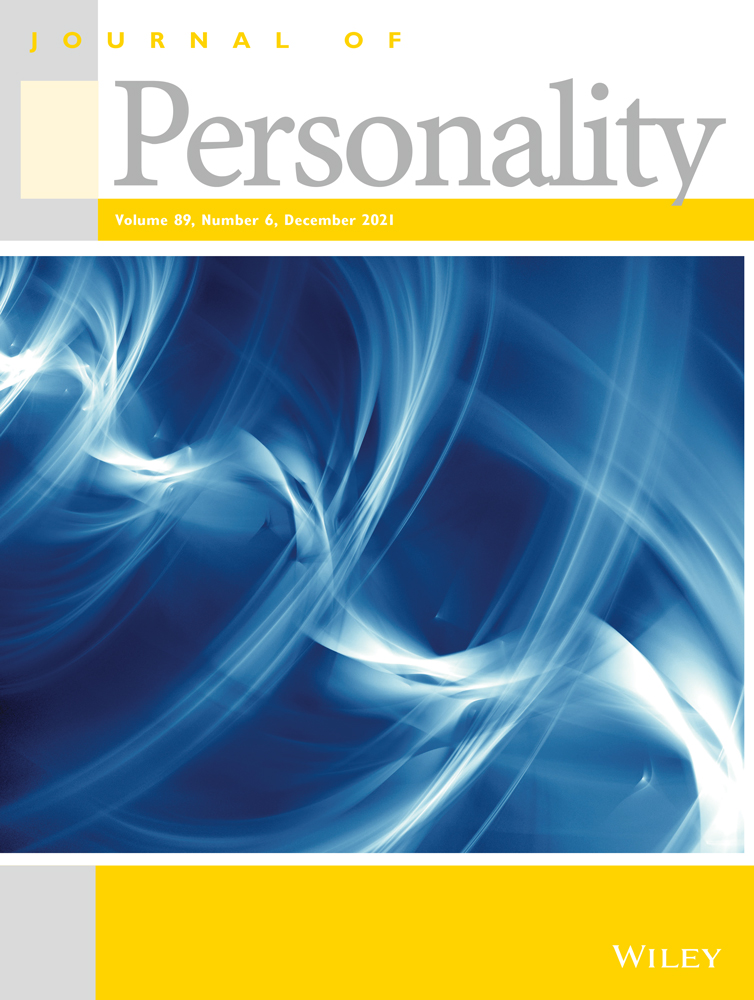Positive and negative urgency as a single coherent construct: Evidence from a large-scale network analysis in clinical and non-clinical samples
Abstract
Aims
Negative and positive urgency are emotion-related impulsivity traits that are thought to be transdiagnostic factors in psychopathology. However, it has recently been claimed that these two traits are closely related to each other and that considering them separately might have limited conceptual and methodological value. The present study aimed to examine whether positive and negative urgency constructs constitute separate impulsivity traits.
Methods
In contrast to previous studies that have used latent variable approaches, this study employed an item-based network analysis conducted in two different samples: a large sample of non-clinical participants (N = 18,568) and a sample of clinical participants with psychiatric disorders (N = 385).
Results
The network analysis demonstrated that items denoting both positive and negative urgency cohere as a single cluster of items termed “general urgency” in both clinical and non-clinical samples, thereby suggesting that differentiating positive and negative urgency as separate constructs is not necessary.
Conclusion
These findings have important implications for the conceptualization and assessment of urgency and, more broadly, for future research on impulsivity, personality, and psychopathology.
1 INTRODUCTION
Negative and positive urgency are emotion-related impulsivity traits that refer to the tendency to act rashly while in an intense emotional state (Cyders & Smith, 2007, 2008), which are included in the influential Urgency–Premeditation–Perseverance–Sensation Seeking–Positive Urgency (UPPS-P) model of impulsivity (Cyders & Smith, 2007; Whiteside & Lynam, 2001). Following Whiteside and Lynam's (2001) seminal work, the UPPS-P impulsivity model has undergone extensive validation research, and the related assessment tools have generally been described as psychometrically robust across various languages, cultures, and populations (e.g., Geurten et al., 2021; Smith et al., 2007). Related findings were mostly based on theoretically sound and reproducible factor structures (established with structural equation modeling), as well as by the high internal consistency and test–retest stability of its sub-components, including positive and negative urgency.
Negative urgency refers to rash actions taken in response to negative emotional states (e.g., sadness, fear, and anger), whereas positive urgency refers to rash actions taken in response to positive ones (e.g., joy and euphoria). The convergence of these two traits, along with their distinct nature compared to other impulsivity constructs, thus pertains to their emotionally-laden nature (Cyders & Smith, 2008). Prior research from these authors, who have coined up the term “positive urgency,” showed that this impulsivity trait predicted risky and/or problematic behaviors (e.g., risky sex, hazardous gambling, and illegal drug use) over and above negative urgency (Cyders et al., 2007; Zapolski et al., 2009), which led to the general assumption that positive and negative urgency are related yet distinct dimensions.
Both negative and positive urgency constructs have been linked to a wide range of externalized (e.g., substance use disorder, gambling/gaming disorders, and aggressive behaviors) and internalized (e.g., anxiety, depression, and PTSD) symptoms (see reviews by Halcomb et al., 2019; Rochat et al., 2018; Zorrilla & Koob, 2019). Furthermore, a meta-analytic review found that, among UPPS impulsivity traits, the urgency traits constitute the strongest markers of psychopathological symptoms (Berg et al., 2015). As evidence linking heightened urgency traits and various psychiatric disorders has bloomed over the last two decades, extensive research has been conducted to elucidate its cognitive, affective, cerebral, and genetic underpinnings (Billieux et al., 2010; Borges et al., 2017; Sanchez-Roige et al., 2019; Wilbertz et al., 2014). Given how urgency traits are assumed in the onset and persistence of mental disorders, these impulsivity components have been suggested to represent transdiagnostic risk factors (Billieux, 2017; Carver & Johnson, 2018; Cyders et al., 2016). Furthermore, calls emerged to foster translational research on urgency in order to develop and test the effectiveness of urgency-focused treatments (e.g., psychological interventions, prevention strategies, and drug medication) targeting specific mechanisms (e.g., psychological, physiological, and neuronal) of urgency traits. Yet, the development of sound clinical models of urgency and related treatments requires more robust evidence regarding its assessment.
Recently, some scholars have started to cast doubts regarding the theoretical and psychometric soundness of distinguishing positive and negative urgency (Berg et al., 2015; Sperry et al., 2018). For instance, although the initial research on positive urgency reported a relatively moderate correlation with negative urgency (r = 0.37, see Cyders & Smith, 2007), numerous studies conducted from then on with the original (59 items) and the short (20 items) versions of the UPPS-P Impulsive Behavior Scales in different cultures have reported higher correlations (with r up to 0.80) between both urgency facets (Billieux et al., 2012; Cándido et al., 2012; Claréus et al., 2017; Cyders et al., 2014; Pedersen et al., 2016; Riley & Smith, 2017). This resulted in the adoption of different strategies to avoid multi-collinearity-related problems, such as computing a “general urgency” variable by grouping both scales (e.g., Banks & Zapolski, 2017; Devos et al., 2020; Dvorak & Day, 2014; Riley & Smith, 2017; Sperry et al., 2018; Stevens et al., 2016), removing one of the two urgency traits from the analysis (Peters et al., 2017), or computing two separate regression models for positive and negative urgency (e.g., Blain et al., 2015; Pedersen et al., 2016). Second, according to a meta-analytic review by Berg and colleagues (2015), existing evidence showed that both urgency traits display a comparable pattern of correlations across various symptoms and mental disorders, which raises questions about the relevance of separating the two traits. Along the same lines, Sperry et al. (2018) suggested a general urgency factor, instead of separate positive and negative urgency facets, based on indistinguishable patterns of relationships with disruptions in affect, cognitions, and behaviors in daily life (e.g., positive urgency was associated with negative affect rather than positive affect). Yet, as these findings result from a study conducted on a relatively small sample of psychology students (N = 294), they should be reproduced in a large and representative sample. Studies using structural equation modeling indicated that hierarchical models where positive urgency and negative urgency are allowed to reflect a higher-order latent construct of “general urgency” were the most adequate to describe the latent factor structure of the UPPS Impulsivity model (e.g., Billieux et al., 2012; Cyders & Smith, 2007). Such hierarchical models conceptualizing “general urgency” as a higher-order construct typically display strong loadings for both positive and negative urgency (e.g., 0.90 and 0.69 in Cyders & Smith, 2007). Taken together, elements mentioned above cast doubt about positive and negative urgency as distinct psychological constructs. Yet, the vast majority of research capitalizing on the UPPS Impulsivity model relies on two different scores for positive and negative urgency traits.
Provided the extensive research agendas on urgency as a trans-diagnostic risk factor of mental disorders and the current enthusiasms at viewing urgency as a promising target ripe for prevention and treatment (Halcomb et al., 2019), it is timely to clarify whether positive and negative urgency do constitute a single coherent construct (as suggested by recent research, e.g., Sperry et al., 2018) or whether they really constitute distinct impulsivity traits that have to assessed by two different subscales. To this end, the current study relies on network analysis (Costantini et al., 2015), which has important advantages over the traditional latent variable approach that has been extensively used to support the existence of two separable urgency-related constructs.
Network analysis is a data-driven approach designed to investigate relationships among a constellation of variables (Cramer et al., 2010), which has gained traction in the last decade in the field of personality psychology (Costantini et al., 2015) and psychiatric research (for a review, see Contreras et al., 2019). This method investigates the relations (called “edges”) between items (called “nodes”). Edges represent the conditional independence between the distinct items. This perspective stands out from the classic latent variable approach, as items organized in a network do not reflect a latent construct but, instead, constitute the construct per se (Guyon et al., 2017). Thus, a major conceptual difference is that, in the latent variable approach, items (e.g., impulsive behaviors as measured in a self-report) are assumed to reflect and be the direct effect of a latent factor (e.g., an impulsive personality trait). In contrast, the principle behind network analysis is that a strong edge suggests that the items are likely to co-occur (Kan et al., 2019). Such a network approach thus challenges the classical latent approach vis-à-vis (a) the identification of important items (those which are more strongly connected to other items in the network, see Fried et al., 2017) and (b) the distinctness of subgroups of items (clusters of nodes) and how they relate (or bridge) to other subgroups (Cramer et al., 2010). Furthermore, network analysis does not assume latent variable common causes. From a statistical point of view, the local independence assumption between items stipulating that covariance between items should be fully explained by the latent factor, is no longer required (Guyon et al., 2017).
Thus, the present study aims to rely upon such a network analysis methodology to examine whether items of positive and negative urgency cohere as a single cluster or emerge as functionally distinct communities (“subnetworks”) of items. Furthermore, we estimated UPPS networks in both clinical and non-clinical sample as most previous psychometric work on the UPPS model was restricted to non-clinical populations.
2 METHODS
2.1 Participants, procedures, and ethical aspects
The non-clinical sample included 18,568 participants (Mage: 26.55; SDage: 10.88; 60.9% women). The participants comprised community participants (63.6% of the sample) or university students. Non-clinical participants completed either an online questionnaire or a paper-and-pencil version in groups of approximately 10 to 100 individuals in their university classes. The clinical sample (i.e., individuals undergoing primary mental healthcare treatment, including mood disorders, anxiety disorders, and addictive disorders) included 385 participants (Mage: 36.54; SDage: 15.86; 39.7% women). Clinical participants completed either an online questionnaire or a paper-and-pencil version in an individual setting (e.g., at the hospital). Participants (clinical and non-clinical) were all French-speaking individuals from France, Belgium, and Switzerland. They provided informed consent prior to their participation. In total, the study relied on 38 independent databases (29 for the non-clinical sample and 9 for the clinical sample) in which the French Short-UPPS-P Impulsive Behavior Scale (s-UPPS-P, see below) was used. Detailed information regarding each database used (e.g., country of origin, investigator responsible of data collection, and type of participants) is available on the Open Science Framework (OSF) at https://osf.io/2p6sx/. The two samples described here have been obtained after listwise deletion of missing data for the s-UPPS-P (the initial sample comprises N = 18,702 participants, see OSF files for further details). The study was not pre-registered, but all data, codes, and materials are available from the OSF link provided.
2.2 Short-UPPS-P impulsive behavior scale
Impulsivity components of the UPPS-P Impulsivity model were assessed with the French short-UPPS-P Impulsive Behavior Scale (s-UPPS-P) developed by Billieux et al. (2012). This instrument is composed of 20 items that assess the five impulsivity components of the UPPS-P model of impulsivity (4 items per impulsivity component), namely negative urgency (e.g., “When I am upset I often act without thinking”), positive urgency (e.g., “When I am really excited, I tend not to think on the consequences of my actions”), premeditation (e.g., “Before making up my mind, I consider all the advantages and disadvantages”), perseverance (e.g., “I finish what I start”), and sensation seeking (e.g., “I sometimes like doing things that are a bit frightening”). The items were scored using a 4-point Likert scale (1 = strongly disagree to 4 = strongly agree). The questionnaire includes both direct and reverse-items to improve the reliability of scores. The factorial structure of the s-UPPS-P was established through confirmatory factor analysis, and the various subscales possess high internal consistency and test–retest stability (Billieux et al., 2012). Descriptive statistics for each item, along with the full scale and coding system (in French and English) can be obtained via the Open Science Framework using the following link: https://osf.io/2p6sx/.
2.3 Data analytic strategy
2.3.1 Removing redundant items
Because the s-UPPS-P was not designed for network analyses and there are items with apparent conceptual overlap, we used a data-driven method to identify potentially redundant nodes. First, we confirmed in the entire sample (clinical and non-clinical) that our correlation matrix was positive definite (reflecting that nodes are not linear combinations of other nodes). Second, we searched for pairs of items that were highly inter-correlated. To do so, we implemented the Hittner method for comparing dependent correlations (Hittner et al., 2003) via the goldbricker function of the R package network tools (Jones, 2018). This approach did not identify any potentially redundant nodes in our entire sample.
2.3.2 Networks estimation and visualization
The two networks computed are composed of nodes (each item) and edges (regularized partial correlations between pairs of nodes controlling for all other nodes in the network). We estimated the networks with the Gaussian graphical model (i.e., a pairwise Markov Random Field model; Epskamp et al., 2018) with a nonparanormal transformation, as some items were not normally distributed (Liu et al., 2012). The model applies a penalty parameter to shrink small coefficients to zero, using the graphical LASSO algorithm, based on the extended Bayesian Information Criterion (Friedman et al., 2008).
2.3.3 Community detection analysis
We tested whether s-UPPS-P items cluster into one or multiple subnetworks (“communities”) in both the non-clinical and the clinical samples. To do so, we implemented the Walktrap community detection algorithm—identifying densely connected subgraphs using short random walks (Yang et al., 2016).
2.3.4 Bridge centrality
Following previous studies (e.g., Everaert & Joormann, 2019; Heeren et al., 2018), we identified important nodes that serve as bridges between the clusters of items identified by the community detection by computing “bridge strength” values. This latter is defined as the sum of the absolute weights of a focal item with all items that are not in the same cluster (Jones et al., 2021). Higher values indicate greater cross-associations with items belonging to other clusters. Significant differences between nodes' bridge strength were investigated using bootstrapped difference tests (https://cran.r-project.org/web/packages/bootnet/bootnet.pdf).
2.3.5 Model accuracy
We also checked our model's accuracy, as previously recommended (Epskamp et al., 2018). All results are interpreted according to the findings of the model's accuracy check (supplementary analyses available on the OSF at https://osf.io/2p6sx/).
We used R 3.5.1 for all analyses, with the package bootnet 1.2.4 (Epskamp et al., 2018) to estimate and visualize the network (default = “huge”), to compute centrality indices, and for bootstrap estimations; the algorithm “walktrap.community” from the igraph 1.2.4.1 package (Csardi & Nepusz, 2006) to detect communities; and the package networktools 1.2.1 to compute bridge centrality indices (Jones, 2018). All data and codes are available on the OSF at https://osf.io/2p6sx/. The results obtained via traditional latent variables analyses (i.e., confirmatory factor analyses of four-factor and five-factor models of the UPPS-P scale, separately for the clinical and non-clinical samples) were also examined and have been made available at https://osf.io/2p6sx/. Note that these confirmatory factor analyses indicated comparable model fit indices for the four- and five-factor models, thus reinforcing the added value of examining the data through the lens of network analysis.
3 RESULTS
3.1 Whole network for non-clinical participants
Figure 1 depicts the resulting network. The community detection analysis identified four clusters of items, dovetailing with the previous literature (i.e., general urgency, lack of perseverance, lack of premeditation, and sensation seeking). Moreover, it fully aligns with our hypothesis that all the items denoting urgency would cluster in a single coherent community of nodes, regardless of their belonging to positive or negative urgency. There were no network differences between gender (for details, see the supplementary analyses at https://osf.io/2p6sx/). The strongest edges correspond to within-cluster edges, as shown in Figure 2. Indeed, the confidence intervals of within-cluster edges (in red) did not overlap with the confidence intervals of between-cluster edges (in black), showing that the firsts were significantly stronger than the seconds. For example, the strongest edge in the network was a within-cluster edge, between items 7 and 17 (general urgency) (estimate = 0.38, 95% confidence interval: 0.36–0.39). The strongest between-cluster edge was between items 5 (lack of perseverance) and 6 (lack of premeditation) (estimate = 0.13, 95% confidence interval: 0.12–0.15). Different clusters were also related by non-null edges. Urgency was related to lack of premeditation (17 positive edges), lack of perseverance (15 positive edges), and sensation seeking (12 positive edges). Lack of premeditation was also related to lack of perseverance (13 positive edges).
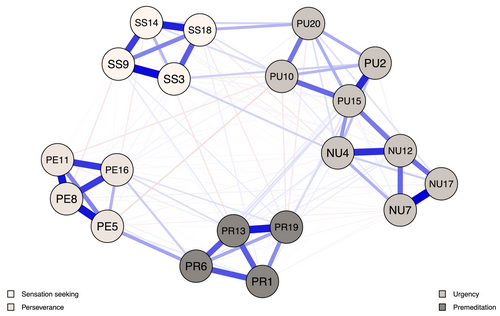
Network of impulsivity items in non-clinical participants (N = 18,568). NU, negative urgency; PE, lack of perseverance; PU, positive urgency; PR, lack of premeditation; SS, sensation seeking. Blue edges indicate positive regularized associations between nodes; red edges indicate negative regularized associations between nodes. Thicker edges denote stronger relationships between nodes. Node colors are defined according to the community detection analysis
[Correction added on 23 August 2021, after first online publication: Figure 1 has updated with high resolution]
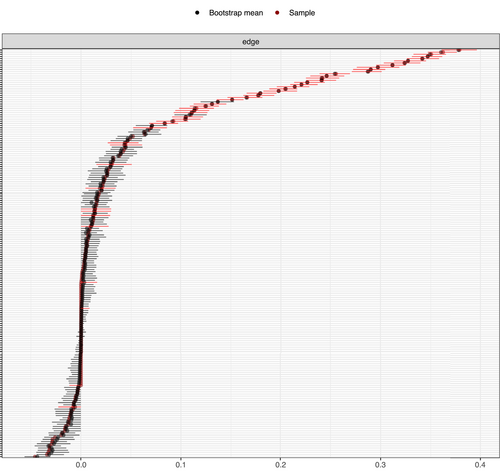
Bootstrapped confidence intervals of estimated edge-weights of the symptom network. The line indicates the edge weights estimated in the sample, with each line corresponding to an edge (red: within-cluster edges, black: between-cluster edges). Edges are ordered from the lowest to the highest. The area indicates the range from the 2.5th to the 97.5th quantiles (bootstrapped 95% confidence interval using 1000 estimations)
[Correction added on 23 August 2021, after first online publication: Figure 2 has updated with high resolution]
3.2 Whole network for clinical participants
Figure 3 shows the network for clinical participants. Again, the community detection analysis identified four clusters of items with a single cluster of general urgency. As depicted in Figure 4, the strongest edges were also within-cluster edges, but different clusters were also related by non-null edges. Urgency was related to lack of premeditation (12 positive edges), sensation seeking (9 positive edges), and lack of perseverance (6 positive edges). Lack of premeditation also had several relationships with lack of perseverance (9 positive edges).
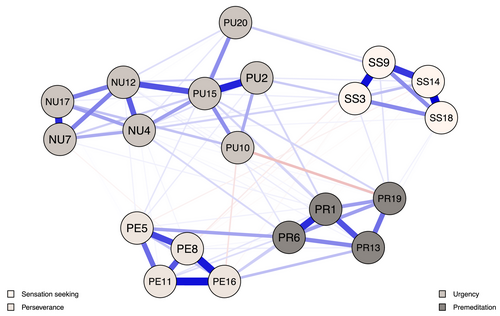
Network of impulsivity items in clinical participants (n = 385). NU, negative urgency; PE, lack of perseverance; PR, lack of premeditation; PU, positive urgency; SS, sensation seeking. Blue edges indicate positive regularized associations between nodes; red edges indicate negative regularized associations between nodes. Thicker edges denote stronger relationships between nodes. Node colors are defined according to the community detection analysis
[Correction added on 23 August 2021, after first online publication: Figure 3 has updated with high resolution]
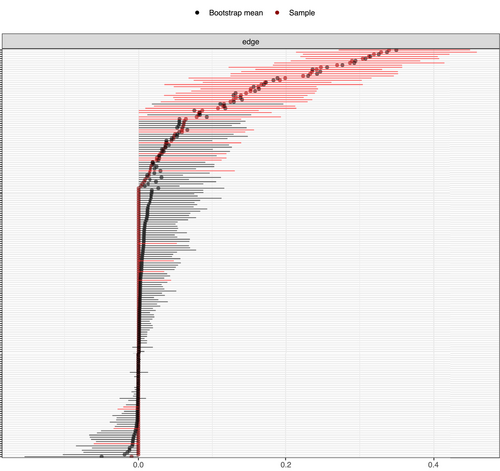
Bootstrapped confidence intervals of estimated edge-weights of the symptom network in clinical participants. The line indicates the edge weights estimated in the sample, with each line corresponding to an edge (red: within-cluster edges, black: between-cluster edges). Edges are ordered from the lowest to the highest. The area indicates the range from the 2.5th to the 97.5th quantiles (bootstrapped 95% confidence interval using 1000 estimations)
[Correction added on 23 August 2021, after first online publication: Figure 4 has updated with high resolution]
4 DISCUSSION
The current study aimed to elucidate whether positive and negative urgency constituted separable constructs, as suggested in past research (Cyders & Smith, 2007; Cyders & Smith, 2007, 2008; Smith et al., 2007). In contrast to previous studies that have relied on latent variable approaches, the present study is the first item-based network approach that combined analyses on a large non-clinical sample (N = 18,568) and a clinical sample (composed of individuals with various types of mental conditions). Indeed, the only published study that has explored the UPPS impulsivity model with network analysis (Goh et al., 2020) relied upon aggregated scores (instead of an item-based approach, as in this study). Moreover, this previous study was conducted among college students, thus hindering the generalizability of the findings. In contrast, ours was conducted in extremely large and well representative samples of clinical and non-clinical community samples. Our study indicated that items of positive and negative urgency emerge as one single coherent cluster both in clinical and non-clinical populations, thereby questioning the dissociation between positive and negative urgency. This finding is of major importance, given the established pivotal role of urgency in reckless behaviors (e.g., Dir & Cyders, 2015; Mostyn Sullivan et al., 2021), and as a transdiagnostic risk factor for mental disorders (e.g., Billieux, 2017; Halcomb et al., 2019; Smith et al., 2013; Zorrilla & Koob, 2019). It is also noteworthy that the network analysis we endorsed allowed for what the traditional latent variables approach was not capable of, that is, settle for a four-factor model (combining both urgency facets together) versus a five-factor model (dissociating the positive and negative urgency facets).1
Our findings yield several conceptual and assessment-related implications. At the conceptual level, our observation that positive and negative urgency constructs emerge as one single coherent cluster dovetails with the view that common psychological (cognitive, emotional, motivational) and biological (brain, genetic) processes involved in emotion-related impulsive behaviors shape the urgency trait, irrespective of its positive or negative nature (Billieux, 2017; Borges et al., 2017; Cyders & Smith, 2008; Rochat et al., 2018). For example, multiple studies linked heightened urgency (positive and/or negative) with compromised inhibitory control as assessed by neuropsychological tasks (Gay et al., 2008; Johnson et al., 2016; Wilbertz et al., 2014). Similarly, Lannoy et al. (2014) showed that urgency, as one whole construct, relates to individual differences in emotion reactivity—that is, the extent to which one experiences emotions intensely, in response to a large array of stimuli, and in a prolonged period of time (e.g., Nock et al., 2008). Along the same lines, recent research suggests that individual differences in emotion reactivity and arousal play a pivotal role in the expression of both positive and negative urgency (Borges et al., 2017; Pearlstein et al., 2019; Sharpe et al.,In press). It is thus probable that common cognitive and affective pathways are involved in urgency-related behaviors, which further supports their grouping in a single and coherent construct. Although past research showed that urgency traits are associated with psychopathological symptoms independently of shared covariation in emotional experiences (Cyders & Coskunpinar, 2010; Smith et al., 2013), one may also wonder whether differences in positive and negative urgency might be at least partly influenced by levels of positive or negative affectivity (such as measured by the Positive and Negative Affect Schedule; Gaudreau et al., 2006). However, further studies that include a measure of negative and positive affectivity are necessary to examine this possibility. Conceptually, reconsidering the distinction between positive and negative urgency will allow for elucidating its core psychological and biological underpinnings and may ultimately contribute to the development of sound transdiagnostic and process-based treatments targeting urgency-related problematic behaviors and psychopathological symptoms.
Our findings also yield implications regarding the assessment of the construct of urgency. In studies where both positive and negative urgency traits are conjointly measured, researchers should be aware that merging both scales is conceptually tenable, which is of major importance given the frequent statistical problems (e.g., multi-collinearity) encountered when using both scales separately. Our findings also call for the development and psychometric analysis of “general urgency items” (example of s-UPPS-P item 4: “When I am experiencing intense emotions, I often act without thinking” instead of “When I am upset, I often act without thinking”).
Our study has several limitations. First, we conceptualized urgency traits as dispositional factors measured through retrospective assessment, known to poorly capture fluctuations in behaviors (Shiffman et al., 2008). Consequently, our study was not in a position to determine whether or not different pathways to impulsive behaviors related to positive and negative urgency exist within the individual. Accordingly, a fine-grained assessment of urgency would require techniques, such as ambulatory assessment, to examine whether positive and negative urgency exhibit differential within-person variability (Sharpe et al., In press). For example, recent research capitalizing on momentary assessment showed that self-reported dispositional negative urgency did not moderate the relation between emotional states and impulsive behaviors (Feil et al., 2020). That being said, most assessment situations capitalize on dispositional measures for feasibility reasons (e.g., time allocated to the patient's assessment in a clinical setting), and our findings demonstrate that, at the dispositional level, positive and negative urgency form a single and coherent construct in both clinical and non-clinical samples. Second, the psychiatric diagnoses endorsed by participants from the clinical group (N = 385) were not considered in the analyses. Information about endorsed psychiatric diagnoses was not coded in our aggregated database for the following reasons: (a) the diagnoses were highly heterogeneous among clinical participants and a substantial proportion of them presented with several comorbid psychiatric disorders; (b) the diagnostic instruments used and coding systems (e.g., ICD and DSM) were not identical among the various treatment centers included in the aggregated database; and (c) some centers whose patients are included in the aggregated database did not use formal psychiatric diagnoses in their clinical practice. Yet, we do not view this as a fatal limitation provided the current conceptualization of urgency as a transdiagnostic factor and not as a feature confined to a specific nosographic entity. Moreover, including a clinical sample is a strength of the present study given the vast majority of previous psychometric work conducted on the UPPS-P impulsivity model relies on non-clinical participants (most of the time university students). Finally, we relied on the short-version of the UPPS-P. Because short-versions might have lower content validity (i.e., they often constitute more “narrow” constructs than those assessed by original scales, see Smith et al., 2000), a critical step would be to replicate the study using the original long version of the UPPS-P Impulsive Behavior Scale. However, previous research showed that the short UPPS-P has an identical factorial structure to that of the original scale, and that its internal reliability coefficients are near to those obtained with the original scale, thus supporting its use in the present study.
To conclude, our results suggest further refinement of the UPPS Impulsivity model, by reconsidering the classical distinction between positive and negative urgency traits in favor of a general urgency trait defined as the “tendency to act rashly in intense emotional contexts.” This reconceptualization of urgency could be a critical step toward the development of sound clinical models of urgency. This may contribute to a better assessment of trait impulsive behaviors and, accordingly, could be critical for evaluating the effectiveness of prevention and treatment interventions targeting this impulsivity trait.
ACKNOWLEDGEMENTS
Our thoughts go to the family and friends of our co-author Martial Van der Linden, who passed away in October 2019 after a long and courageous fight against illness. We mourn a great man and a great psychologist. We would like to thank Martial for his humanity and his mentoring of several of the current paper's authors. We would like to thank Christina Burkhard, Stéphanie Caillies, Alessandra Dosch, Jory Deleuze, Fanny Kreusch, David Magalon, Catherine Potard, and Nicolas Simon for their precious help with regard to data collection. George A. Michael and Romain Bet were supported by the University of Lyon 2 and the CH Le Vinatier/Lyon 2 (CSLV17) convention. The authors are also thankful to Marie Annelise Blanchard for her helpful comments on an earlier draft of this paper. Alexandre Heeren and Pierre Maurage (Research Associates) are supported by the FRS-FNRS Belgian Science Foundation (F.S.R.-FNRS). At the time of the study, Séverine Lannoy was funded by the Belgian Fund for Scientific Research (FRS-FNRS). Séverine Lannoy received salary support from the Belgian American Educational Foundation (BAEF). Open Access Funding provided by Universite de Lausanne.
CONFLICT OF INTEREST
The authors declare no conflict of interest.
ETHICS STATEMENT
Each of the independent databases included in the current study comes from projects with ethical clearance (for research aims unrelated to the current study, as here we have conducted secondary data analysis to test a new research hypothesis).
AUTHOR CONTRIBUTIONS
Joël Billieux operationalized the study hypothesis, organized the collection of the aggregated database, and wrote the first draft of the manuscript in collaboration with Stéphanie Baggio and Alexandre Heeren. Joël Billieux, Aline Wéry, Gaëtan Devos, Séverine Lannoy, and Maèva Flayelle conducted a literature search to identify representative papers dealing with positive and negative urgency multi-collinearity-related problems. Stéphanie Baggio computed the network analysis and the Structural Equation Modeling analyses reported in the Open Science Framework (OSF). Alexandre Heeren, Joël Billieux, and Adriano Schimmenti contributed to the data-analytic strategy. Joël Billieux, Stéphanie Baggio, Adriano Schimmenti, Lucien Rochat, and Alexandre Heeren interpreted the results. Joël Billieux was responsible for uploading the data and protocol in the Open Science Framework (OSF). Adriano Schimmenti, Daniel King, and Natale Canale revised the initial draft and participated in the writing of the final draft. All other authors were involved in the supervision of data collection. All authors approved the final version of the manuscript.



